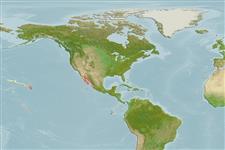>
Trachichthyiformes (Roughies) >
Anomalopidae (Lanterneye fishes)
Etymology: Phthanophaneron: Greek, phthano = to arrive the first + Greek, phaneros = visible (Ref. 45335); harveyi: Named for E. Newton Harvey.
Eponymy: Dr Edmund Newton Harvey (1887–1959) was an American zoologist who was a leading expert on bioluminescence, probably inspired during an expedition to the South Pacific (1913). [...] (Ref. 128868), visit book page.
More on authors: Rosenblatt & Montgomery.
Environment: milieu / climate zone / depth range / distribution range
Écologie
marin démersal; profondeur 32 - 36 m (Ref. 39674). Subtropical
Eastern Pacific: known only from the Gulf of California.
Taille / Poids / Âge
Maturity: Lm ? range ? - ? cm
Max length : 8.0 cm TL mâle / non sexé; (Ref. 11482)
Description synthétique
Clés d'identification | Morphologie | Morphométrie
Épines dorsales (Total) : 5; Rayons mous dorsaux (Total) : 14; Épines anales: 2; Rayons mous anaux: 10. Eye prominent with subocular light organ. 13 abdominal scutes.
A specimen taken from a steep sandy slope with profuse black coral growth.
Life cycle and mating behavior
Maturité | Reproduction | Frai | Œufs | Fécondité | Larves
Allen, G.R. and D.R. Robertson, 1994. Fishes of the tropical eastern Pacific. University of Hawaii Press, Honolulu. 332 p. (Ref. 11482)
Statut dans la liste rouge de l'IUCN (Ref. 130435: Version 2024-1)
Menace pour l'homme
Harmless
Utilisations par l'homme
Pêcheries: commercial; Aquarium: Aquariums publics
Outils
Articles particuliers
Télécharger en XML
Sources Internet
Estimates based on models
Preferred temperature (Ref.
123201): 16.4 - 26.9, mean 20.1 °C (based on 34 cells).
Phylogenetic diversity index (Ref.
82804): PD
50 = 1.0020 [Uniqueness, from 0.5 = low to 2.0 = high].
Bayesian length-weight: a=0.01122 (0.00514 - 0.02450), b=3.04 (2.87 - 3.21), in cm total length, based on all LWR estimates for this body shape (Ref.
93245).
Niveau trophique (Ref.
69278): 3.4 ±0.5 se; based on size and trophs of closest relatives
Fishing Vulnerability (Ref.
59153): Low vulnerability (10 of 100).
